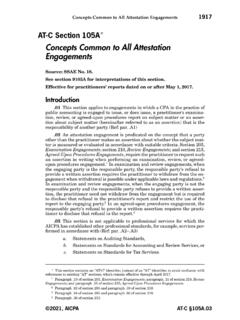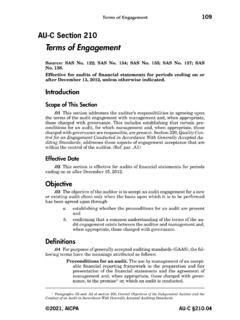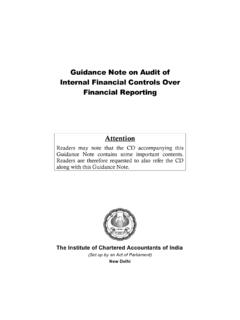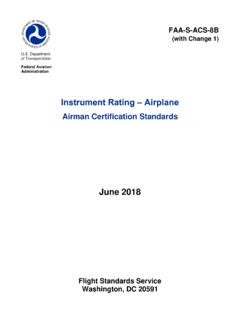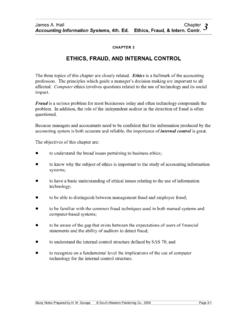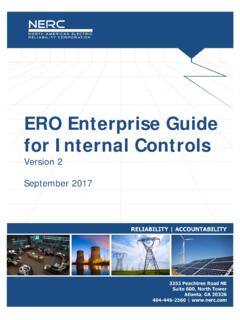Transcription of De-Identification of Personal Information
1 NISTIR 8053 De-Identification of Personal Information Simson L. Garfinkel This publication is available free of charge from: NISTIR 8053 De-Identification of Personal Information Simson L. Garfinkel Information Access Division Information Technology Laboratory This publication is available free of charge from: October 2015 Department of Commerce Penny Pritzker, Secretary National Institute of Standards and Technology Willie May, Under Secretary of Commerce for Standards and Technology and Director ii National Institute of Standards and Technology Internal Report 8053 vi + 46 pages (October 2015) This publication is available free of charge from: Certain commercial entities, equipment, or materials may be identified in this document in order to describe an experimental procedure or concept adequately.
2 Such identification is not intended to imply recommendation or endorsement by NIST, nor is it intended to imply that the entities, materials, or equipment are necessarily the best available for the purpose. There may be references in this publication to other publications currently under development by NIST in accordance with its assigned statutory responsibilities. The Information in this publication, including concepts and methodologies, may be used by Federal agencies even before the completion of such companion publications. Thus, until each publication is completed, current requirements, guidelines, and procedures, where they exist, remain operative. For planning and transition purposes, Federal agencies may wish to closely follow the development of these new publications by NIST.
3 Organizations are encouraged to review all draft publications during public comment periods and provide feedback to NIST. All NIST Computer Security Division publications, other than the ones noted above, are available at National Institute of Standards and Technology Attn: Computer Security Division, Information Technology Laboratory 100 Bureau Drive (Mail Stop 8930) Gaithersburg, MD 20899-8930 iii Reports on Computer Systems Technology The Information Technology Laboratory (ITL) at the National Institute of Standards and Technology (NIST) promotes the economy and public welfare by providing technical leadership for the Nation s measurement and standards infrastructure. ITL develops tests, test methods, reference data, proof of concept implementations, and technical analyses to advance the development and productive use of Information technology.
4 ITL s responsibilities include the development of management, administrative, technical, and physical standards and guidelines for the cost-effective security and privacy of other than national security-related Information in Federal Information systems. Abstract De-Identification removes identifying Information from a dataset so that individual data cannot be linked with specific individuals. De-Identification can reduce the privacy risk associated with collecting, processing, archiving, distributing or publishing Information . De-Identification thus attempts to balance the contradictory goals of using and sharing Personal Information while protecting privacy. Several laws, regulations and policies specify that data should be de-identified prior to sharing.
5 In recent years researchers have shown that some de-identified data can sometimes be re-identified. Many different kinds of Information can be de-identified, including structured Information , free format text, multimedia, and medical imagery. This document summarizes roughly two decades of De-Identification research, discusses current practices, and presents opportunities for future research. Keywords De-Identification ; HIPAA Privacy Rule; k-anonymity; differential privacy; re- identification ; privacy Acknowledgements John Garofolo and Barbara Guttman provided significant guidance and support in completing this project. The author would also like to thank Daniel Barth-Jones, David Clunie, Pam Dixon, Khaled El Emam, Orit Levin, Bradley Malin, Latanya Sweeney, and Christine M.
6 Task for their assistance in answering questions and reviewing earlier versions of this document. More than 30 sets of written comments were received on Draft 1 of this document from many organizations including Anonos, Center for Democracy and Technology, Future of Privacy Forum, GlaxoSmithKline, IMS Health, Microsoft, Optum Privacy, Patient Privacy Rights, Privacy Analytics, and World Privacy Forum. We also received comments from the members of COST Action IC1206 De-Identification for Privacy Protection in Multimedia Content, Dr. Marija Krlic, Prof. Samir Omarovic, Prof. Slobodan Ribari and Prof. Alexin Zoltan. Audience This document is intended for use by officials, advocacy groups, researchers and other members of communities that are concerned with policy issues involving the creation, use and sharing of data containing Personal Information .
7 It is also designed to provide technologists and researchers with an overview of the technical issues in the De-Identification of data. Data protection officers iv in government, industry and academia will also benefit from the assemblage of Information in this document. While this document assumes a high-level understanding of Information system security technologies, it is intended to be accessible to a wide audience. For this reason, this document minimizes the use of mathematical notation. NISTIR 8053 De-Identification of Personal Information v Table of Contents 1 Introduction .. 1 Document Purpose and Scope .. 1 Intended Audience .. 1 Organization .. 1 Notes on Terminology .. 2 De-Identification , redaction, pseudonymization, and anonymization.
8 2 Personally Identifiable Information (PII) and Personal Information .. 3 2 De-Identification , Re- identification , and Data Sharing Models .. 3 Motivation .. 3 Models for Privacy-Preserving use of Private Information .. 6 Privacy Preserving Data Mining (PPDM) .. 7 Privacy Preserving Data Publishing (PPDP) .. 8 De-Identification Data Flow Model .. 9 Re- identification Attacks and Data 9 Release models and data controls .. 14 3 Approaches for De-Identifying and Re-Identifying Structured Data .. 15 Removal of Direct Identifiers .. 15 Pseudonymization .. 16 Re- identification through Linkage Attacks .. 17 De-Identification of Quasi-Identifiers .. 19 De-Identification of Protected Health Information (PHI) under HIPAA.
9 22 The HIPAA Expert Determination Method .. 22 The HIPAA Safe Harbor Method .. 23 Evaluating the effectiveness of the HIPAA Safe Harbor Method .. 25 HIPAA Limited Datasets .. 26 Evaluation of Field-Based De-Identification .. 26 Estimation of Re- identification Risk .. 29 4 Challenges in De-Identifying Unstructured Data .. 30 De-identifying medical 30 De-identifying Photographs and Video .. 32 De-Identifying Medical Imagery .. 35 NISTIR 8053 De-Identification of Personal Information vi De-identifying Genetic Information and biological materials .. 36 De-Identification of geographic and map data .. 37 5 Conclusion .. 38 List of Appendices Appendix A Glossary .. 39 Appendix B Resources .. 44 Official publications.
10 44 Law Review Articles and White Papers: .. 45 Reports and Books: .. 46 Survey Articles .. 46 NISTIR 8053 De-Identification of Personal Information vii NISTIR 8053 De-Identification of Personal Information 1 1 Introduction De-Identification is a tool that organizations can use to remove Personal Information from data that they collect, use, archive, and share with other organizations. De-Identification is not a single technique, but a collection of approaches, algorithms, and tools that can be applied to different kinds of data with differing levels of effectiveness. In general, privacy protection improves as more aggressive De-Identification techniques are employed, but less utility remains in the resulting dataset. De-Identification is especially important for government agencies, businesses, and other organizations that seek to make data available to outsiders.










